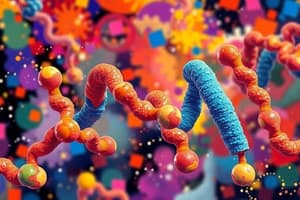Podcast
Questions and Answers
What are proteins composed of?
What are proteins composed of?
Amino acids
What is the most important role of proteins as enzymes?
What is the most important role of proteins as enzymes?
Serve as metabolic catalysts and regulate the chemical reactions within cells
What are the four levels of protein structure?
What are the four levels of protein structure?
- Primary Structure (correct)
- Quaternary Structure (correct)
- Tertiary Structure (correct)
- Secondary Structure (correct)
What forms the primary structure of a protein?
What forms the primary structure of a protein?
What maintains the secondary structure of a protein?
What maintains the secondary structure of a protein?
What determines the tertiary structure of a protein?
What determines the tertiary structure of a protein?
What are lipoproteins?
What are lipoproteins?
What are glycoproteins?
What are glycoproteins?
What is the significance of polypeptide chains?
What is the significance of polypeptide chains?
How are amino acid monomers linked together?
How are amino acid monomers linked together?
Flashcards are hidden until you start studying
Study Notes
Proteins Overview
- Proteins are diverse biological molecules made up of amino acids.
- They perform nearly every dynamic function in the body and exist in thousands of different forms, each with specific structures and functions.
Amino Acids
- Proteins consist of 20 different amino acid monomers arranged in various sequences.
- Each amino acid has an amino group, a carboxyl group (making it an acid), a hydrogen atom, and an R group that determines its unique properties.
Polypeptide Chains
- Amino acids are linked into polypeptide chains through dehydration reactions, forming peptide bonds.
- Polypeptide chains fold to create functional proteins, with categories including enzymes and structural proteins.
Protein Functions
- Enzymes act as metabolic catalysts, regulating cellular chemical reactions.
- Structural proteins provide physical support (e.g., hair).
- Other protein types include:
- Contractile: Found in muscles
- Defensive: Include antibodies for immune response
- Signal: Hormones and chemical messengers
- Receptor: Transmit signals into cells
- Transport: Carry oxygen
- Storage: Supply amino acids for developing embryos
Levels of Protein Structure
- Proteins have four levels of structure:
- Primary Structure: The amino acid sequence, determined by genetic information.
- Secondary Structure: Coiling (alpha helix) or folding (pleated sheet) maintained by hydrogen bonds.
- Tertiary Structure: The overall three-dimensional shape of a protein.
- Quaternary Structure: The arrangement of multiple polypeptide chains in proteins like hemoglobin.
Specialized Proteins
- Lipoproteins: Combinations of lipids and proteins, significant in cholesterol transport, affecting heart disease risk (HDLs and LDLs).
- Glycoproteins: Composed of carbohydrates and proteins, often serving as signal-receiving receptors on cell surfaces.
Studying That Suits You
Use AI to generate personalized quizzes and flashcards to suit your learning preferences.




